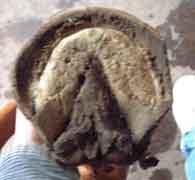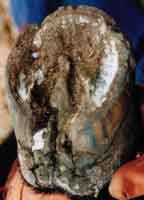A world of information is available at www.barefoothorse.com. This following article makes us stop and think how important natural horse care is and finding the right protective horse boots that are available, starting with EasyCare, the leader in hoof boots!
When we pull the shoes, nearly all horses are found to have substantial internal damage to the hooves. It takes about a year of special care to re-build good feet; we call this healing time the “transition year.” The occasional horse that doesn’t have transition soreness generally had shoes for only a few months.
Horseshoes seem to have been invented in the Middle Ages in Europe, to keep the feet from falling apart when knights’ horses had to live for months in slop-filled tie-stalls while the castle was under siege. At that time, the modern study of Anatomy and Physiology did not exist yet, so there was no way to study what the shoes did to hooves and legs.
Horses today are high-priced performance animals and valued companions, and are not kept in unsanitary conditions that rot their feet. A long life and lifelong soundness are important to most horse owners. Therefore, it is time to re-think the use of horseshoes.
There are more than a dozen ways that shoes are known to damage the feet, legs, and circulatory system of the horse (see A Lifetime of Soundness by Dr. Hiltrud Strasser). The worst damage comes from loss of circulation in the hoof, and loss of shock absorption.
Circulation: When the horse steps down on his foot, the cone-shaped hoof wall flexes wider at the bottom; when he lifts it off the ground, it returns to its narrower “closed” shape. This spread-and-squeeze acts like a pump, pulling blood into the foot with each step.
Horsehoes are nailed onto the foot when it is in the closed, off-the-ground position. With a shoe on, the hoof can’t flex, so the pump doesn’t work; not enough blood and nutrients are pulled into the foot to build and maintain strong tissues. Therefore, the quality of sole, wall, and frog is poor; injuries are slow to heal; and the white line deteriorates over time and becomes stretchy.
A rough estimate is that a medium-sized, barefoot horse pumps a gallon (4 liters) through its four feet in about 20 strides. If anyone has more accurate information I will put it here.
Shock absorption: In the tough yet elastic barefoot hoof, the flexing of the weighted hoof can absorb as much as 2,000 lbs. of concussion. But the horseshoe holds the foot inflexible, cancelling out 75% of its ability to absorb shock. Instead, the concussion goes on up the leg and damages joints and tendons that were not designed to take so much shock.
A third type of damage is that shoes contract the hoof. The hoof naturally grows in a cone shape; as the hoof wall grows, the base (the part that touches the ground) gets wider. But shoes hold the base to the size it was on shoeing day. The shod hoof changes from a cone to more of a cylinder shape. The heels are forced to curl inward, which puts incorrect mechanical stress on the hoof wall, and can show up as wall cracks, white line damage, or heel pain.

An overgrown hoof that was not shod, showing how the hoof gets wider as it grows.

An overgrown hoof that was shod, showing how the shoe made the hoof grow in a cylinder shape with “underslung heels.”
The horse’s feet keep growing till age 5, when he reaches his full adult weight. When shoes are put on a young horse, the coffin bone cannot grow wider, and the foot ends up small for the horse, and often contracted.
For these and many other reasons, the barefoot horse has a lot of advantages over the shod horse, both in health and in performance.
Posted by Marcie Mendoza




